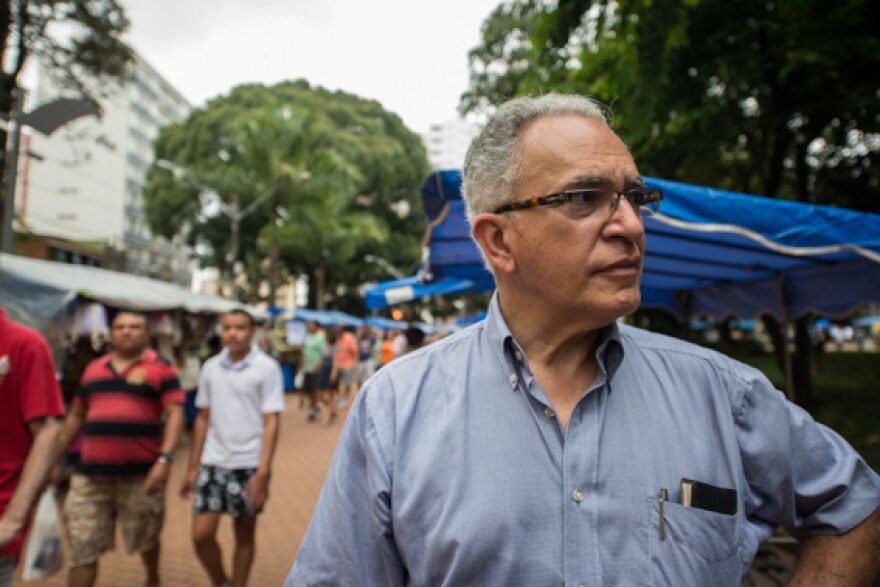Emilio Moran is a world-renowned social anthropologist who has studied and published in tropical agriculture, social science, ecology, economics, and, most recently, earth observations from satellites.
Moran’s true discipline is asking the right questions and merging human and environmental sciences to get a holistic understanding of some of the world’s most crucial problems—climate change, land use—and a project he pioneered some 30 years ago: determining the potential of the humid tropics for intensive agriculture.
Moran is a John A. Hannah Distinguished Professor with the Department of Geography, Environment, and Spatial Sciences, the Center for Global Change and Earth Observations, the Environmental Science and Policy Program, the Center for Latin American and Caribbean Studies, and the Center for Systems Integration and Sustainability at Michigan State University.
“I've been working for several decades, mostly in the Amazon, and Africa, too. I've worked on agriculture and what is known as land use and demographic change, migration and demography. My work is probably best known for, for the first time, using remote sensing to examine very small fields in farms to understand how people make decisions about how much rain forest to cut and how much to cultivate. And I’ve studied what happens after you deforest the rainforest.”
Moran’s latest work centers around the environmental and economic impact of hydroelectric dams in Brazil.
“We have found there are many dimensions to this work. The turbine is the thing we want to deliver at the end, something very practical and usable that people can be given for their energy use. How can we serve off-grid communities anywhere in the world? I have credibility from working in the Amazon for so many years. People believe me when I say I can do this. Most people can't do it; it's too hard a place to work. But people believe that I can do it because I've done it for a long, long time.
“We're excited about the potential. Now, the challenge ahead is, how can we convince Brazil and the energy sector in Brazil that this is doable, that they should be moving in this direction? And they should, because Brazil is the most dependent country on hydropower. A few years ago, they were 80 percent dependent on hydropower for all their electrical consumption. They got that down to 67 percent, but solar is still less than one percent in Brazil of their energy needs. And wind power is increasing rapidly, and they already out-compete the smaller dams. But smaller dams do as much damage as the big dams. They block the river so the fish still cannot get through. The damage can actually be worse from having 14 or 15 small conventional dams compared to a big dam. And in fact, in another project that I have, we're working on investigating and comparing a string of small hydropower dams with the big ones to see which one actually causes more damage. We'll be doing that for the next three or four years.
“Support science and encourage people to innovate and not to think inside the box. We've been building hydropower dams for a long, long time, since the turn of the other century. In fact, the first dam was built in Grand Rapids, Michigan. So we have a history of building dams. We have over 2,000 dams in Michigan at the moment, many provide hydropower. We are possibly starting to look at Michigan as an object of study. We're looking for the right place in which to do it. But we have a big problem in Michigan. Most of those dams were built in the '30s. They're already 20 to 30 years past their expected lifetime. Most of them are, by the evaluation of the people who monitor dams in Michigan, considered to be dangerous. They're considered to be high-risk dams.
“We already had a breach recently in central Michigan, and this is going to happen more and more. And I'm just amazed that so little is being done to address the problem. Everybody somehow is comfortably enjoying the reservoir for their recreational activity and not thinking that a lot of those reservoirs are high-risk dams that are likely to breach unless either we invest a lot of money in fixing them, or we spend a lot of money removing them. But as they stand, it is a high-risk situation for human life and property. Our research offers a solution. If what we want is the sustainable energy source of hydropower, this technology can do it.
“And at some point we even discussed in our group, can we put our turbine in Old Town in Lansing as a demonstration to show people that this is possible? Because there used to be a hydropower dam there in Old Town. It no longer generates power; it's too old. By putting something in the same place to show that we can generate power for Old Town, for example, is something that we might undertake. It would be a good investment for Michigan that will take us in a direction that would be safer for our citizens. And that would put us at the forefront of new technology for the nation.”
MSU Today airs every Sunday morning at 9:00 on 105.1 FM, AM 870, and however you stream at home. Follow and subscribe at Spotify, Apple Podcasts, and wherever you get your podcasts.

